Dog Snapper, Lutjanus jocu
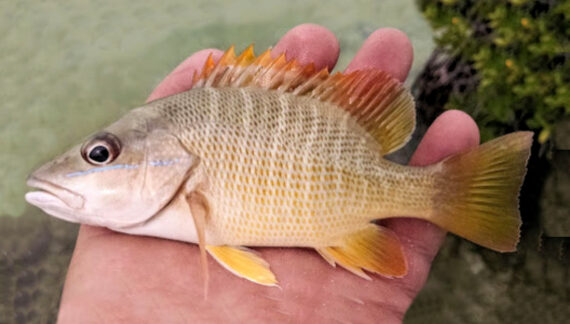 Dog Snapper, Lutjanus jocu, Juvenile. Fish caught from coastal waters off Punta Nizuc, Cancun, Quintana Roo, July 2015. Length: 12 cm (4.7 inches). Catch, photograph and identification courtesy of Marc Eberlein, Grand Rapids, Michigan.
Dog Snapper, Lutjanus jocu, Juvenile. Fish caught from coastal waters off Punta Nizuc, Cancun, Quintana Roo, July 2015. Length: 12 cm (4.7 inches). Catch, photograph and identification courtesy of Marc Eberlein, Grand Rapids, Michigan.
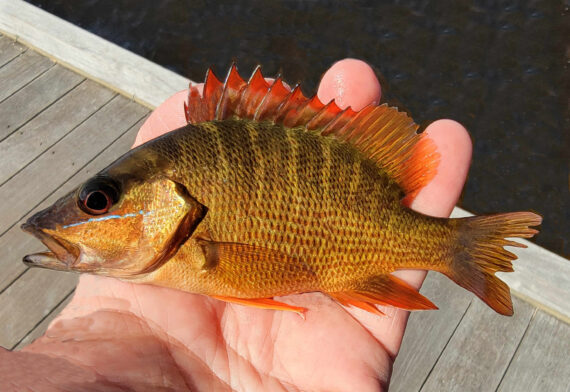 Dog Snapper, Lutjanus jocu, Juvenile. Fish caught from the St. Lucie Rivier, Port Salemo, Florida, November 2023. Length: 13 cm (5.1 inches). Catch, photograph and identification courtesy of Chris Moore, Peoria, Arizona.
Dog Snapper, Lutjanus jocu, Juvenile. Fish caught from the St. Lucie Rivier, Port Salemo, Florida, November 2023. Length: 13 cm (5.1 inches). Catch, photograph and identification courtesy of Chris Moore, Peoria, Arizona.
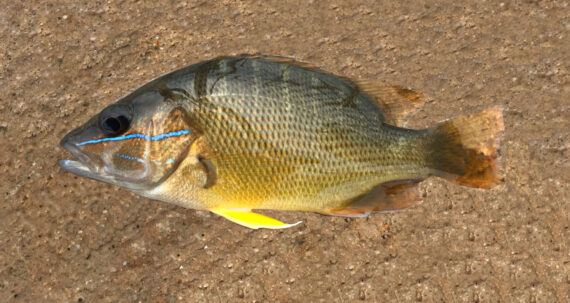 Dog Snapper, Lutjanus jocu, Juvenile. Fish caught from the Packery Channel Jetty, Corpus Christi, Texas, August 2018. Length: 14 cm (5.5 inches). Catch, photograph and identification courtesy of Luke Ovgard, Klamath Falls, Oregon.
Dog Snapper, Lutjanus jocu, Juvenile. Fish caught from the Packery Channel Jetty, Corpus Christi, Texas, August 2018. Length: 14 cm (5.5 inches). Catch, photograph and identification courtesy of Luke Ovgard, Klamath Falls, Oregon.
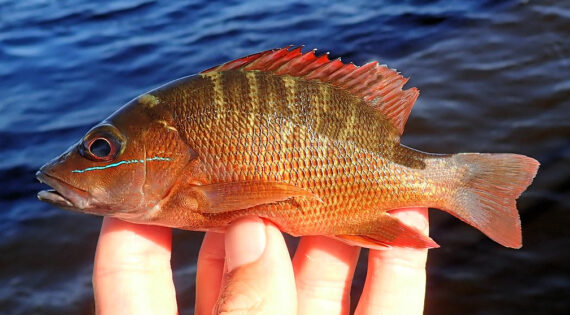 Dog Snapper, Lutjanus jocu, Juvenile. Fish caught from coastal waters off Sebastian, Florida, November 2021. Length: 15 cm (5.9 inches). Catch, photograph, and identification courtesy of Ben Cantrell, Sebastian, Florida.
Dog Snapper, Lutjanus jocu, Juvenile. Fish caught from coastal waters off Sebastian, Florida, November 2021. Length: 15 cm (5.9 inches). Catch, photograph, and identification courtesy of Ben Cantrell, Sebastian, Florida.
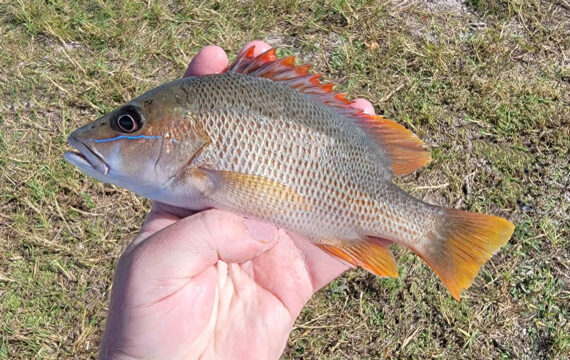 Dog Snapper, Lutjanus jocu. Fish caught from coastal waters off Boca Raton, Florida, November 2023. Length: 16 cm (6.3 inches). Catch, photograph and identification courtesy of Chris Moore, Peoria, Arizona.
Dog Snapper, Lutjanus jocu. Fish caught from coastal waters off Boca Raton, Florida, November 2023. Length: 16 cm (6.3 inches). Catch, photograph and identification courtesy of Chris Moore, Peoria, Arizona.
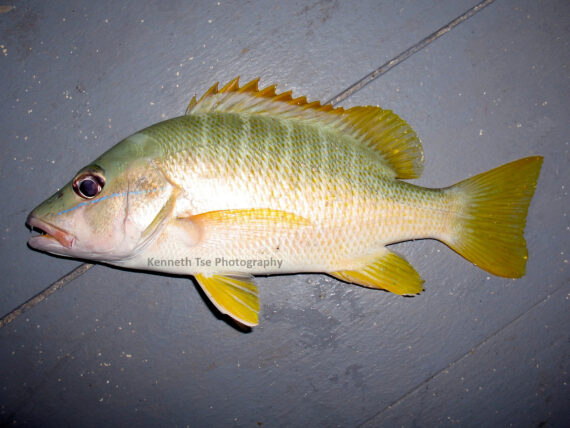 Dog Snapper, Lutjanus jocu. Fish caught in coastal waters off Tobacco Caye, Belize, June 2013. Length: 31 cm (12 inches). Catch, photograph and identification courtesy of Kenneth Tse, Toronto, Ontario, Canada.
Dog Snapper, Lutjanus jocu. Fish caught in coastal waters off Tobacco Caye, Belize, June 2013. Length: 31 cm (12 inches). Catch, photograph and identification courtesy of Kenneth Tse, Toronto, Ontario, Canada.
The Dog Snapper, Lutjanus jocu, is a member in the Snapper or Lutjanidae Family, that is also known as the Atlantic Dog Snapper and in Mexico as pargo caballera. Globally, there are sixty-seven species in the genus Lutjanus, of which nineteen are found in Mexican waters, ten in the Atlantic and nine in the Pacific Ocean. The Dog Snapper received its common name form the long canine teeth that remain visible even when their mouth is closed. They are of scientific interest as they travel large distances to reach specific spawning locations which they return to on annual cycles at the same time each year.
The Dog Snapper has a relatively deep body. They are olive-green dorsally, transitioning to a pale copper color ventrally. Their anal, caudal, second dorsal, pectoral and pelvic fins are yellow with a red tinge; their first dorsal fin has a red margin. Juveniles are a reddish-brown, with a light blue line under their eyes that extends into the gill cover, narrow pale bars and yellow ventral fins; adults have a distinct white triangle bar under their eyes and a row of light blue spots under their eyes that extends into the gill cover. Their anal fin Is rounded with 3 spines and 8 rays; their caudal fin is straight or slightly concave; their dorsal fin is continuous with 10 spines and 14 or 15 rays and the pectoral fins are long and reach the anus. Their mouth is large with large prominent canines. They have 12 to 14 gill rakers on the lower arch. They are covered with scales and are oblique above the lateral line.
The Dog Snapper is normally a solitary reef dweller that can be found inshore or near shore with rocks or reefs, at depths between 5 m (16 feet) and 590 m (100 feet). Juveniles can be found inshore within estuaries, mangroves and seagrass beds and are known to enter freshwater rivers and streams. They reach a maximum of 1.28 m (4 feet 2 inches) in length and 28.6 kg (63 lbs) in weight. As of January 1, 2024, the International Game Fish Association world record for weight stood at 10.9 kg (24 lbs 0 oz) with the fish caught in coastal waters of the Bahamas in May 1994. They are an aggressive nocturnal carnivore that feeds on smaller fish and benthic invertebrates, including cephalopods, crabs, gastropods and shrimp. In turn they are preyed upon by barracuda, grouper, moray eels, and other snappers. Their eggs, larvae and juveniles, are preyed upon by a wide variety of marine organisms. Reproduction is oviparous with fish migrating long distances to aggregate in large numbers in specific locations. Their eggs and larvae are planktonic and pelagic, dispersed by the currents. The juveniles are found close to shore and in estuaries within shallow water seagrasses and mangrove habitats for protection against predation. They have life spans of up to 29 years.
The Dog Snapper is a resident of all Mexican waters of the Atlantic Ocean including the Gulf of Mexico and the east coast of the Yucatán Peninsula in the Caribbean.
The Dog Snapper is a straightforward identification with the exception that their juveniles are very similar to the Schoolmaster, Lutjanus apodus (no white triangle under the eye; yellow fins).
The Dog Snapper is a resident of all Mexican waters of the Atlantic Ocean including the Gulf of Mexico and the Caribbean with the exception that they are absent from along the east coast of the in the States of Tamaulipas and northern Veracruz.
From a conservation perspective the Dog Snapper is currently considered to be of Least Concern with stable, widely distributed populations. However, the habitat they use for juvenile development is subject to destruction caused by coastal development. They are a focus of commercial fishermen during spawning season and are caught with handlines, gill nets, seines, traps and spears. They are prone to overfishing, with noted significant declines in the landings of mature fish, during spawning season as they become sitting ducks. They are also a bycatch of the Atlantic Red Snapper fishery. They are considered to be a quality food fish but larger fish are reported to contain ciguatoxin. They are sold in domestic markets, mainly In Mexico City and Guadalajara. Total catches until the 1980s were estimated at about 20 to 25 metric tons per year, but have sharply declined since 1980. They are also targeted year-round by recreational anglers. Significant regulations have been established that include daily bag limits and seasonal closures, to give them some level of protection. Such support is either non-existent or not enforced in many parts of their range. They are also utilized by the aquarium trade and are frequently found in large public aquariums.